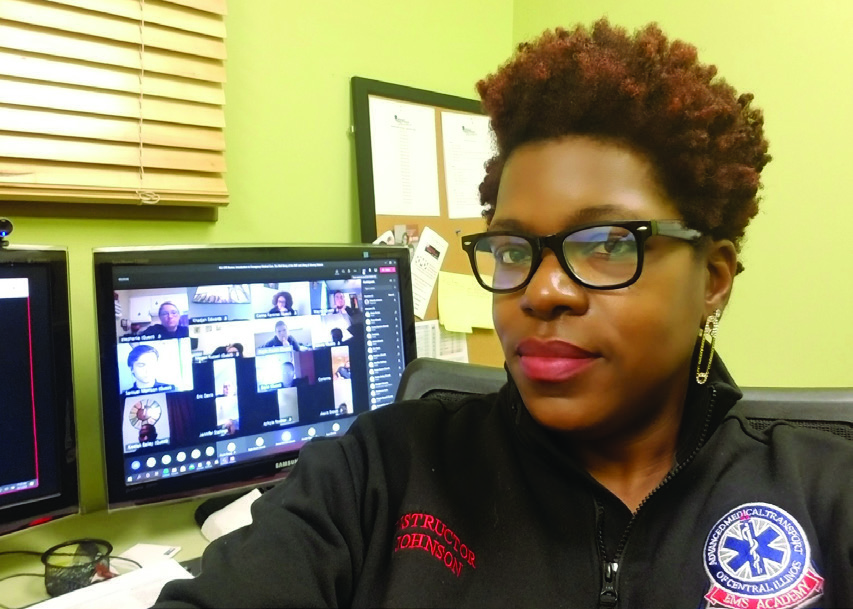
EMS EDUCATOR FACES NEW CHALLENGES Yolanda Johnson spent 10 years on an ambulance in Peoria, IL, before becoming an EMS instructor.
Yolanda Johnson drove by Advanced Medical Transport of Central Illinois’s headquarters every day on her way to work at a facility for the mentally and physically disabled. At the time, she didn’t even know that the organization, known as AMT, was a local EMS service.
“But I remember noticing a ‘Now Hiring’ sign on the building,” says Johnson. “Around the same time, I was watching the local news and they were covering an accident.”
She recalls noticing a woman who looked a lot like her. “When I saw her—a young, black woman who was part of the rescue team wearing her AMT uniform, it just clicked for me,” Johnson says. That’s when she decided to shift to a career in EMS, saying to herself, “I bet I can do that.”
It turns out that Johnson, who was always interested in healthcare, was a perfect fit. Today, after more than 13 years at AMT in Peoria, Illinois, first as an EMT on an ambulance and now as an EMS educator, Johnson is thrilled to pass on her knowledge. “I like watching each student come on the first day—nervous, afraid and uncertain. But, by the end of the program, they‘re more confident and educated on all the basics of becoming an EMT.”
THINGS GET REAL ON DAY THREE
Although she values in-class training immensely, Johnson believes that experience provides the best education. She remembers when things got real her third day in the field. “We got a call for a motor vehicle accident, but when we arrived on scene, it was much more than an MVA. The patient had actually been shot in the head and left for dead. I was calm, cool and shaking in my boots all at the same time,” she laughs. “To make matters worse, the patient was combative and didn’t want anyone touching him except me. Thankfully, the seasoned medic I was with really knew her stuff and she walked me through every step perfectly within my scope of practice.”
It became clear on that day that EMS was going to be an exciting and challenging career. “You know, as an EMT, you’re part cardiologist, part pulmonologist, part endocrinologist and everything else,” Johnson says. “We have to be good at all of it.”
EDUCATING THE NEXT GENERATION
After 10 years on an ambulance, Johnson now spends most of her time educating new EMTs as an EMS Lead Instructor, CPR Instructor and coordinator of AMT’s Cardio Reviver program, which donates to nonprofits that meet the criteria of public access AEDs and trains lay people in CPR.
“Preparing for a class takes a full day,” she says. “I make sure to stay current with the trends of EMS. I research, read and make presentations and study guides for each chapter. Each class is different so
I cannot approach each class the same and I am always looking for new ideas to teach.”
Due to COVID-19, Johnson has moved many of her courses online, which has made everyone work harder. “I was definitely a little uncertain about it at first,” she says. “I thought, ‘How can I present all of this information to new students—all of whom have no idea about EMS?’ They have to really want this for it to work.”
Fortunately, AMT has the space to accommodate small groups of students for in-person, hands-on sessions once they’ve completed the online course. “I tell my students to come in mentally prepared because the time we get to spend at our facility is short—and valuable. It’s all about the hands-on experience and giving students constructive feedback. I want to see and hear how they interact with the mannequin—what they say and what they do. EMS is all about communication and the touch.”
ADVICE FOR EMS PEERS
What advice does Johnson have for other EMS professionals? She emphasizes two things: Be vocal about your career goals and take care of your mental health.
“If you want to move ahead, of course you need to work hard and prove yourself, but you have to let it be known when you’re interested in a new position,” says Johnson. “Knowing the job, having enthusiasm, a can-do attitude, being approachable and available, being easy to talk to—those are all things that play into your success. But above all, let your goals be known.”
Johnson understands that the mental toll on EMTs is real and she even teaches a dedicated well-being class. She recommends prioritizing communication with colleagues and management, having regular debriefing sessions and taking mental health days when things get overwhelming.
“I tell my students that every day is not going to be a good day and that we are not saving everyone,” she says. “All we can do is work to the best of our abilities.”
